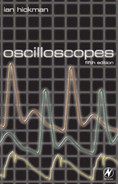
Appendix
1
Cathode
ray
tube
phosphor
data
Human
eye response
An important factor in selecting a phosphor
is
the corour or
radiant energy distribution
of
the light output. The human eye
responds in varying degrees
to
light wavelength
from
deep red
to
violet. The human eye is most sensitive
to
the yellow-green
region; however, its responsiveness diminishes on either side
in
the orange-yellow area and the blue-violet region. The eye is
not
very receptive
to
deep blue or red.
If
the quantity
or
light
falling
on
the eye is doubied, the
brightness ‘seen‘
by
the eye does not double. The brightness
of
a
colour tone
as
sccn
is
approximately proportional to the
log
of
energy
of
the stimulus.
The
t
~rin
/umifzum>
is
1
he
photometric
cqu
iva
Icn
t
of
b
ri
gh
mess.
11
is based
on
measurcmcnts made with
a
wnsor having
a
spectral
sensitivity curve rurrecied
lo
that
of
the average
huimri
cyc.
The
S1
(inlernalional metric standard) units
for
lrirninance are
candelas per squarc mctrc, bur. footlamberts arc still used
extensively in
thy
US;
1
footlambert
=
0.2919
candelaim’.
The
term luminance implies that data has been measured
or
corrected
to incorporate the
CIE
standard eye response curve
for
the
human eye.
CIE
is
an abbreviation
for
Commission Inter-
nationale de L‘Eclairage (Internal Commission
on
Illumination).
The luminance graphs and
tables are therefore useful only when
the phosphor
is
being viewed.
Phosphor protection
When
a
phosphor
is excited by an electron beam with
an
excessively high current density,
a
perrnancnl
loss
of
phosphor
efficiency
may
occur.
The light output
of
the damagcd phosphor
will
be
reduced, and in
cxircmc
cases cornplere desrruction
of
thc
phosphor may
rcsulr.
Darkening
or
burning occurs whcn
the

Comparative CRT phosphor data
Phosphor ~ Fluorescence Relative Relative
and Relative photographic burn
WTDS JEDC phosphorescence luminance x writing speed 3 Decay resistance Comments
GJ P1 Yellowish-green 50% 20% Medium Medium Replaced by GH (P3 l) in
most applications
WW P4 White 50% 40% Medium-short Medium-high Television displays
GM P7 Blue 5 35 % 75 % Long Medium Long decay, double-layer
screen
BE P11 Blue 15 % 100% Medium-short Medium For photographic
applications
GH P31 Green 100% 50% Medium-short High General purposes,
brightest available
phosphor
GR P39 Yellowish-green 27% NA 4 Long Medium Low refresh rate displays
GY P43 Yellowish-green 40% NA 4 Medium Very high High current density
phosphor
GX P44 Yellowish-green 68% NA 4 Medium High Bistable storage
WB P45 White 32% NA 4 Medium Very high Monochrome TV displays
i Tektronix is adopting the Worldwide Phosphor Type Designation System (WTDS) as a replacement for the older JEDEC 'P' number system reference. The
chart lists the comparable WTDS designations for the most common 'P' numbers.
2 Measured with Tektronix J16 Photometer and J6523 Luminance Probe which incorporates a CIE standard eye filter. Representative of 10 kV aluminized
screens. GH (P31) as reference.
3 BE (P11) as reference with Polaroid 612 or 106 film. Representative of 10kV aluminized screens.
4 Not available.
5 Yellowish-green phosphorescence.
BE (P11) phosphor has a different spectral output from GH (P31) phosphor standard and more closely matches the sensitivity spectrum of silver halide film
types. While photographic writing speed is approximately two times the GH (P31) rate, the visual output luminance is approximately 15% of GH (P31)
phosphor standard, using Polaroid Film Type 107, 3000 ASAw/out film fogging.

252 Oscilloscopes
heat developed by electron bombardment cannot be dissipated
rapidly enough by the phosphor.
The two most important and controllable factors affecting the
occurrence of burning are beam-current density (controllable
with the intensity, focus and astigmatism controls) and the length
of time the beam excites a given section of the phosphor
(controllable with the time/div control). Of the total energy from
the beam, 90 per cent is converted to heat and 10 per cent to
light. A phosphor must radiate the light and dissipate the heat, or
like any other substance it will burn. Remember, burning is a
function of intensity and time. Keeping the intensity down or the
time short will save the screen.
Photographic writing rate
Photographic writing rate is a measure of the scope/camera/film's
capability to record high-speed signals.
Recording high-speed signals on film is dependent on at least
three factors: the oscilloscope used, film characteristics, and the
camera. For maximum writing rate capability, the objective is to
get as much light energy to the film surface as possible. Since
each component affects photographic writing rate, the selection
for top performance is important. The phosphor offering the
highest photographic writing rate is BE (P11). A c.r.t, with this
phosphor is therefore usually specified for an oscilloscope which
is required to record photographically very fast single events,
which leave too faint a trace to be observed visually. However, a
microchannel plate c.r.t. (Figure 9.11) enables one to see clearly
single shot events at the full bandwidth of the oscilloscope. For
this reason, GH (P31) phosphor is standard on MCP c.r.t.s.
Note
The information in this appendix is reproduced by courtesy
of Tektronix UK Ltd.
..................Content has been hidden....................
You can't read the all page of ebook, please click here login for view all page.
